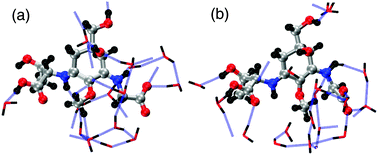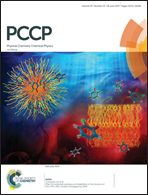How seaweeds release the excess energy from sunlight to surrounding sea water†
Abstract
We report an atomistic insight into the mechanism regulating the energy released by a porphyra-334 molecule, the ubiquitous photosensitive component of marine algae, in a liquid water environment upon an electron excitation. To quantify this rapidly occurring process, we resort to the Fourier analysis of the mass-weighted auto-correlation function, providing evidence for a remarkable dynamic change in the number of hydrogen bonds among water molecules and between the porphyra-334 and its surrounding hydrating water. Hydrogen bonds between the porphyra-334 and close by water molecules can act directly and rather easily to promote an efficient transfer of the excess kinetic energies of the porphyra-334 to the surrounding solvating water molecules via an activation of the collective modes identified as hydrogen-bond stretching modes in liquid water which eventually results in a disruption of the hydrogen bond network. Since porphyra-334 is present in seaweeds, aquatic cyanobacteria (blue-green algae) and red algae, our findings allow addressing the question how algae in oceans or lakes, upon sunlight absorption, can release large amounts of energy into surrounding water without destabilizing neither their own nor the H2O molecular structure.

- This article is part of the themed collection: 2017 PCCP HOT Articles


 Please wait while we load your content...
Please wait while we load your content...